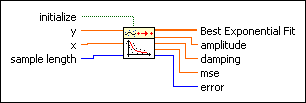Exponential Fit PtByPt VI
Owning Palette: Fitting PtByPt VIs
Requires: Full Development System
Finds the exponential curve values and the exponential coefficients amplitude and damping, using the least-squares solution, which describe the exponential curve that best represents the input set of data points defined by sample length.
This VI is similar to the Exponential Fit VI.
 | Note By default, reentrant execution is enabled in all Point By Point VIs. |

 Add to the block diagram Add to the block diagram |
 Find on the palette Find on the palette |





